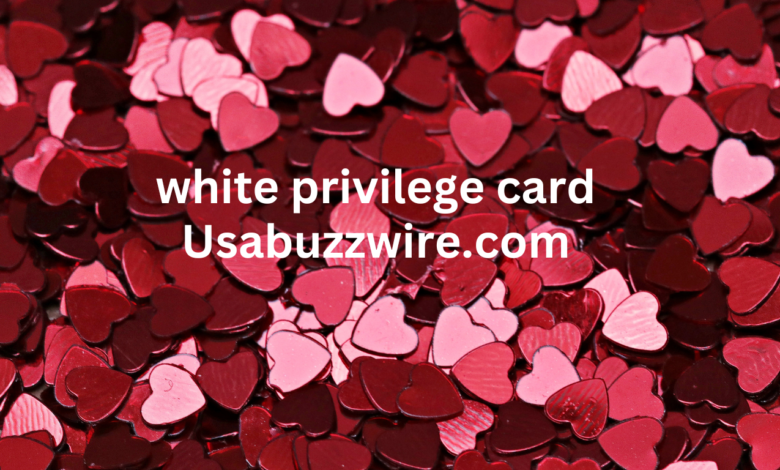The White Privilege Card Phenomenon A Tool for Reflection or Division

In recent years, the concept of the “white privilege card” has generated intense debates, especially as society continues to grapple with issues of race, privilege, and systemic inequality. This term is both provocative and polarizing, sparking conversations about whether it’s a helpful tool for reflection or a symbol of division. In this article, we will explore the origins, implications, and debates surrounding the white privilege. Analyzing whether it encourages introspection or deepens societal divides.
Understanding the White Privilege Card
The “white privilege” is not a literal card. But rather a metaphor used to symbolize the unearned advantages that white individuals experience over people of color. These privileges are often invisible to those who benefit from them. Which is why the term has gained traction in discussions surrounding race and inequality.
The card acts as a reminder that being white in a society built to favor white individuals often comes with implicit advantages. These privileges can manifest in numerous ways, such as receiving better treatment from law enforcement, gaining easier access to quality education and healthcare. Or facing fewer societal barriers in daily life.
The Origins of the White Privilege Card
The term “white privilege” was first introduced by sociologist Peggy McIntosh in 1988, through her essay titled “White Privilege: Unpacking the Invisible Knapsack.” In this essay, McIntosh highlighted the unspoken benefits that white people receive simply because of their race, such as being able to navigate society without fear of racial profiling or discrimination.
Although McIntosh didn’t mention the “white privilege” specifically, the concept evolved in popular culture to serve as a more visual representation of these societal advantages. The term “white privilege” gained prominence as a way to challenge white individuals to confront their unacknowledged privileges and reflect on their role in perpetuating racial inequalities.
Heliocare A Comprehensive Guide to Protecting Your Skin from Sun Damage
The White Privilege Card as a Tool for Reflection
For many, the white privilege card serves as an important tool for self-reflection. It encourages white individuals to acknowledge the advantages they may have experienced throughout their lives, often without even realizing it. This moment of awareness is crucial, as it opens the door to understanding how deeply entrenched racism and inequality are in many facets of society.
Encouraging Critical Thought
The white privilege prompts individuals to consider questions like:
- How often have I been given opportunities because of my race?
- How frequently have I been treated with respect or trust due to my skin color?
- What privileges do I unknowingly carry with me every day?
These are not simple questions, and their answers can sometimes be uncomfortable. However, these reflections are necessary if society is to make real progress toward equality. By asking these questions, individuals can begin to understand how race impacts their lives and why conversations about privilege are essential for social change.
A Wake-Up Call for Greater Awareness
For many people, the white privilege serves as a wake-up call. It forces white individuals to recognize that their experiences, while valid, may not be universally shared. This realization is crucial in fostering a more empathetic and socially conscious mindset. Understanding the extent of white privilege can serve as a first step in becoming a better ally to marginalized communities.
By using the white privilege card in discussions, individuals are also prompted to reflect on how they can use their privileged status to advocate for change, whether through social activism, support for equal policies, or by simply listening to the voices of those who have experienced oppression firsthand.
The White Privilege Card as a Source of Division
While some people see the white privilege as a valuable tool for social awareness, others view it as a divisive force. The primary criticism comes from those who argue that conversations about white privilege often lead to feelings of shame, guilt, or defensiveness, especially among white individuals who may feel personally attacked.
Defensiveness and Backlash
For some, the notion of white privilege can be difficult to digest. White individuals who have experienced hardship or come from disadvantaged backgrounds may feel that their struggles are minimized when the conversation shifts to privilege. They may argue that not all white people benefit equally from societal systems and that their personal experiences don’t align with the concept of white privilege.
In these cases, the white privilege can be seen as a tool of division. Instead of promoting constructive dialogue. It may inadvertently cause some people to become defensive and reject the concept of privilege altogether. When conversations about privilege become accusatory. It can further alienate individuals who might otherwise be open to learning and engaging in discussions about racial inequality.
Weaponization of the White Privilege Card
In some instances, the white privilege card has been weaponized in the culture wars. It is sometimes used as a tool to dismiss conversations about systemic racism. With critics arguing that it is an unfair method of blaming white people for issues they may not have directly caused. In these contexts. The card is often employed as a rhetorical device to undermine conversations about race and to accuse those advocating for social justice of being overly divisive.
Some far-right groups and conservative commentators have seized upon the white privilege to mock and discredit discussions on race. By framing the concept as a form of social control or “virtue signaling,” these critics aim to delegitimize efforts to address racial inequality. Reducing the conversation to a point of satire.
The Debate: Reflection or Division?
The central debate around the white privilege boils down to its role in conversations about race. Is it a helpful tool for self-reflection and societal change. Or is it a divisive symbol that only deepens societal rifts?
When Used as a Reflection Tool
When used properly, the white privilege can be a valuable tool for introspection and understanding. By challenging white individuals to think critically about their own position within a system that advantages them. The card encourages greater self-awareness and empathy. It serves as an important educational tool, helping people understand that racial inequality is not just a personal issue. But a deeply embedded societal problem.
By acknowledging the privileges that come with being white, individuals can work towards becoming allies for racial justice, advocate for systemic change. And contribute to a more inclusive society.
When Used to Divide
On the other hand, when the white privilege card is used in an accusatory or divisive manner. It can have the opposite effect. Rather than fostering constructive conversations, it may lead to defensive reactions, alienation, and a refusal to engage in meaningful dialogue. It risks shifting the focus away from real issues and turning discussions about racial inequality into personal attacks.
This can create a toxic atmosphere where individuals are reluctant to participate in discussions about race for fear of being labeled or accused. In these cases, the white privilege loses its potential for positive change and becomes a tool of polarization.
Conclusion
The white privilege card is a powerful, yet controversial, symbol in the ongoing conversation about race and privilege in society. While it can serve as a tool for critical reflection and societal awareness. It also has the potential to divide and alienate people if used improperly. Whether it becomes a force for good or a point of contention depends largely on how it is deployed in conversations about race.
Ultimately, the white privilege is a reminder of the work that still needs to be done to address racial inequality. It challenges individuals to confront uncomfortable truths, acknowledge their privileges, and work towards creating a more equitable society. However, to ensure that these conversations lead to real change, they must be approached with empathy, understanding. And a commitment to constructive dialogue.
Designing the Future The Beauty and Benefits of Bubble House




